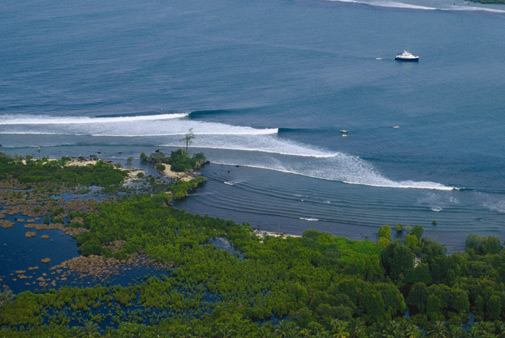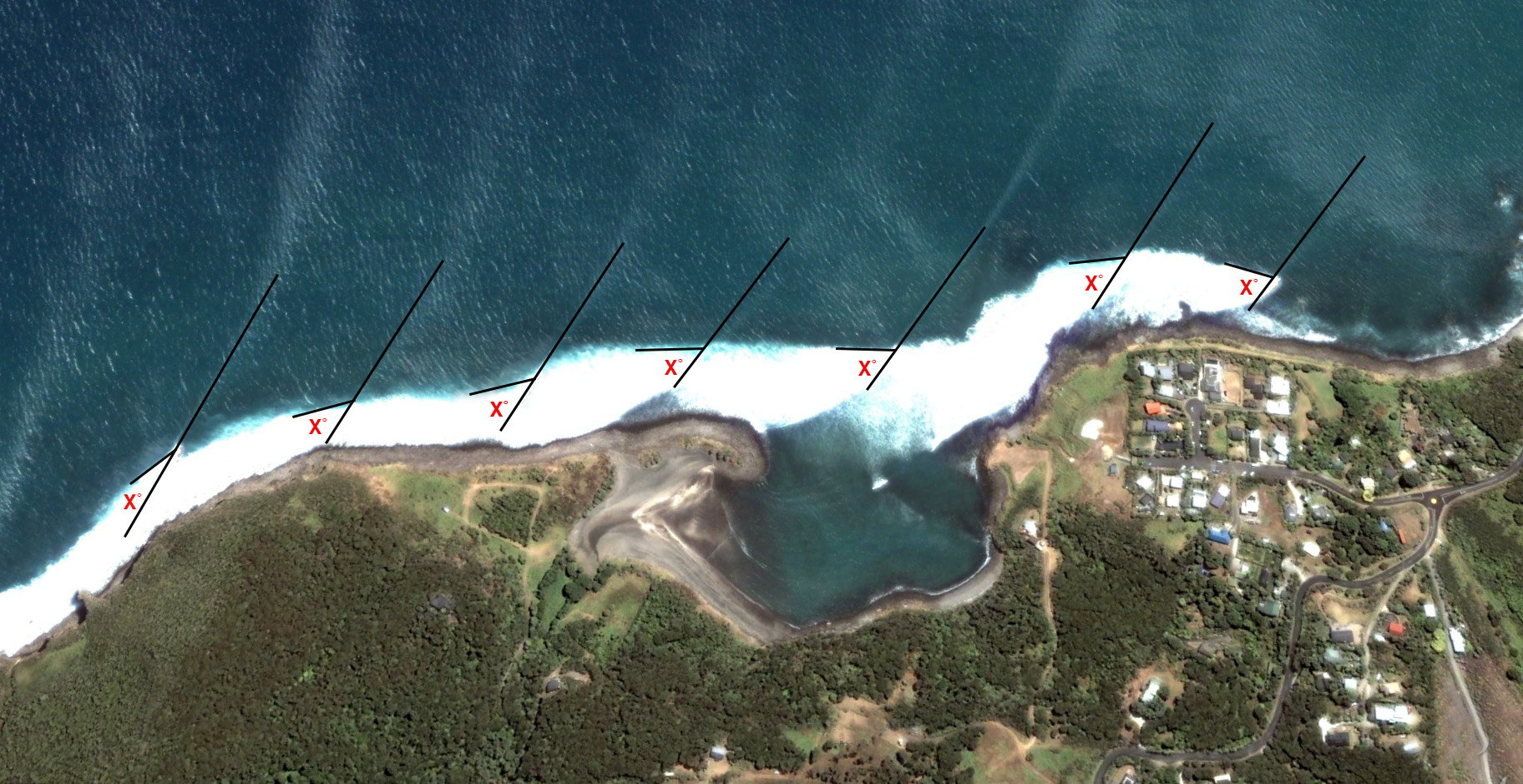Coastal Creationism - Part 1: Basic reef shapes
 What is a perfect reef and why are they so rare?
What is a perfect reef and why are they so rare?
Surfers instinctively know a perfect reef when they see one. Of course they're easy to identify by the perfect waves breaking with mechanical precision, but the big problem is that perfect reefs are few and far between and new reefs are damn hard to find. Maybe they only break perfectly with a rare swell, wind, and tide combination. Or perhaps the perfect reef shape is rare, kind of like the shape of one of those ‘magic’ surfboards: everything about it is just right, but you never find another board like it.
One thing we know for sure is the precise three-dimensional geometry of a perfect reef is a natural wonder that's difficult to understand and almost impossible to replicate.
Yet because reefs are a function of natural processes and these processes can be described and analysed by science, there has been some credible research into what makes perfect surf reefs so extraordinary. Some of the most detailed work has been done in the effort to replicate these natural wonders and create artificial surfing reefs.
Of course science is an iterative process where many different researchers over time will build on the body of research to eventually unlock solid working knowledge of the processes. However, we are still waiting for science to deliver on its two most eagerly awaited discoveries. No, not the Grand Unifying Theory and evidence of dark matter, functional hoverboards and perfect artificial reefs are the breakthroughs we await.
At this stage the science behind artificial surfing reefs is a fast developing work in progress. However, a combination of what has been learned so far on artificial surfing reefs along with a scientific understanding of geology, geomorphology, and coastal processes, we can gain a better understanding of natural surfing reefs - and in the process hopefully find a few hidden gems.
Firstly, what makes a great surfing reef? What are the underwater shapes that turn swell, tide, and wind into epic waves? Keeping in mind that surfers of different abilities and equipment are seeking different versions of perfection to suit their wave riding style and speed.
The work of surf scientists to quantify what we want was codified by James ‘Kimo' Walker at the University of Hawaii in 1972 and looked at ‘peel angle’ relative to wave height and related this to surfing ability. This initial work was significantly refined by Hutt et al (2001) looking at the variety of sections at Raglan during a good swell and across the tidal cycle.

The peel angle - X˚ - as demonstrated by a set peeling down Raglan from Indicators, where the peel rate is fastest, past The Valley and into Whale Bay, where the peel rate is slowest
The important number is the peel angle, defined as the angle between the line of the crest of the unbroken swell and the line traced by the whitewater as the breaking curl peels along the reef. Summarising, most surfers want a peel angle between 50 degrees - which provides slow but fun waves - to 30 degrees - which describes fast, down the line waves. Beyond 27 degrees most waves would peel too fast to be be ridable for even the best surfers on the fastest equipment. You and I would call it a closeout.
The next parameter that matters is wave steepness. Science defines four main wave breaking types: spilling, plunging, collapsing and surging.
- A spilling wave is best described as a slow fat wave, without a clearly defined lip. A mushburger in other words.
- A plunging wave is what most surfers are after, however the term is too broad as it incorporates everything from a gently throwing, thin-lipped peeler through to the most extreme mutant slab.
- A collapsing wave is something beyond a slab, where the lip undersucks and turns the wave inside out, rendering it a useless boil of whitewater.
- A surging wave is what we see when a wave just runs up a steep, high energy beach - expending its energy without forming a wave face.
So when we are looking for a good surfing reef, it is clear that surfers want a very specific reef shape that will turn commonly occurring swell, wind, and tide combinations into a plunging wave that will peel along the reef at an optimal angle.
In subsequent articles we will examine the reefs shapes that surfers rate most highly, and how bedrock geology and coastal processes come together to create the magic. We'll also look at regional differences and why this means some sections of coast are better than others for creating pumping waves. This also means we can also look at other sections of coast and find out why they are so crap and dissapointing. Stay tuned...
Coastal Creationsim is the first of an eight part series written by Chris Buykx. Chris Buykx is a geologist, traveller and lifelong surfer. Specialising in eco-tourism, his passion is interpreting nature and the environment. Chris is a resident of Sydney’s Northern Beaches though he's currently doing a lap of Australia with his family.
(homepage photo of Macaronis by Nathan Smith/SurfAid)

Comments
I haven't been this excited about a series since the release of 'Two and a Half Men'
Coupla questions, Gaz -
Which men? why were they held captive? Are you really Fritzl?
Well with my strapping physique I often apply the amount of spray tan recommended for one-and-a-half men, so when I head out into the surf with one of my buddies I say we're just like two and a half men. LOLZ!
Could you be one of my buddies Clivus? Gary knows one when he sees one.
You're definitely Fritzl, aren't you?
I bet you've got lovely smooth skin, Clivus
Calm down Gary, we will need to hose you down.
I've never found a wet t-shirt competition I didn't like.
Interesting topic. The next phase would be to document the 'peel' angles of various points along our coast. Then see if we could 'fill in' holes / gaps to make a continuous reef break. Cant see why not. Eco friendly, spreads the crowd, makes reefs for fish - should be win - win for all.
...ignoring the inevitable changes/impacts that would occur somewhere else as a result, of course.
In the complex structures making up a reef or coastline section, the changes may not be 'inevitable'. 'Impacts' may not be pronounced or significant. That statement is unsubstantiated. The benefits may far out weigh any perceived negative changes to coastline. The fundamental issue as this article has highlighted, is the need for 'quality' surf.
Also, and keep in mind I'm not advocating laissez faire tampering of the coast, other ocean users modify the coast for their own ends with nary a peep from surfers. Think of boaters dredging channels (Currumbin), boat ramps, wharves, rock groynes etc etc.
Hey Chris Buykx > I'm very interested in this series too.
Uncannily I'm looking for an oceanographer that understands surfing to inform two artworks that are key to an exhibition I'm curating. Is that you? Would you be willing to share on a couple of specifics? Not wanting to bore the general Swellnet audience, could I email you? Stu can connect us, if confidentiality is an issue? RR
Awesome! Can't wait to see the whole article
Cool. Hey after this could you please write an article detailing reasons why the banks around Illawarra beaches have sucked for 15 years? That'd be great! I'd love to know. Like, wtf happened to Corrimal? Used to be 7 or 8/10 on good days. Now it sits at 3 or 4/10 on those same days and never gets better :(
http://www.swellnet.com/news/swellnet-analysis/2015/10/07/damned-marram-...
Dafuq!?! LoL. That was quick!
Anything for the fans.
There is a lot still to talk about in this series - including what is wrong with some coasts - and what is right!
As ACB has pointed out, Craig's Marram Grass article helped set the tone. It was awesome because it highlights just how dynamic coasts can be. Change one thing - and then something else changes as a result. Sand is so dynamic it is almost too hard to analyse, so i will be mainly looking at reefs.
I am going to try and build a sequence in understanding the important factors that make surf spots great. In 35,000km of travel this year I have learned a very important reality - good surf spots are actually very, very rare!
There's a spot here in Geraldton that never used to break untill the council dredged a deep shipping channel and built a few groins along the foreshore. now when the swells big enough the swell focuses perfectly onto a groin, which makes one fine little poor mans macaronis on its day but the shipping channel has also ruined a lot of other places in Geraldton such as sunset, which locals say all the breaks there were much better.
Seperation point in Gero used to be epic but now needs a 5 metres swell to be 3-4 ft. i dont know why that is, every local has a different story but they say something along the lines of "man fucked with something and now its ruined."
Heres one photo of the fun maccas spot

Unreal Groundswell.
When i was there with a mate for 6 months in 1980, we'd surf Sunset maybe 3 or 4 days a week. It was our standard spot and used to get some great waves. Only surfed Sepo once in that 6 mths - it looked like it had potential but never showed it. We often watched Hells Gates cranking but got spooked by how far out it was, how mean it looked and the stories of sharks and hell currents.
Anyway, a few years ago, my wife & I passed thru and I checked out Sunset on a reasonable swell, expecting it to be packed and cranking but it was small, crappy and nobody out. In fact i didn't see anyone surfing anywhere around town. Dunno why.
Groundswell, I couldn't believe that spot. I hadn't been to Gero since the 90s and was back there last year strolling the footpath after checking out the Maritime museum only to discover this crazy 1 - 2ft barrel spitting off that groyne in the middle of a weekday with no-one out. Before my missus could say 'are we going to the shops?' I ripped off my tshirt and body surfed it for about an hour. I frothed out big time. It was one hell fun novelty wave alright. I grabbed my board later that day but the tide seemed to have swallowed up the swell.